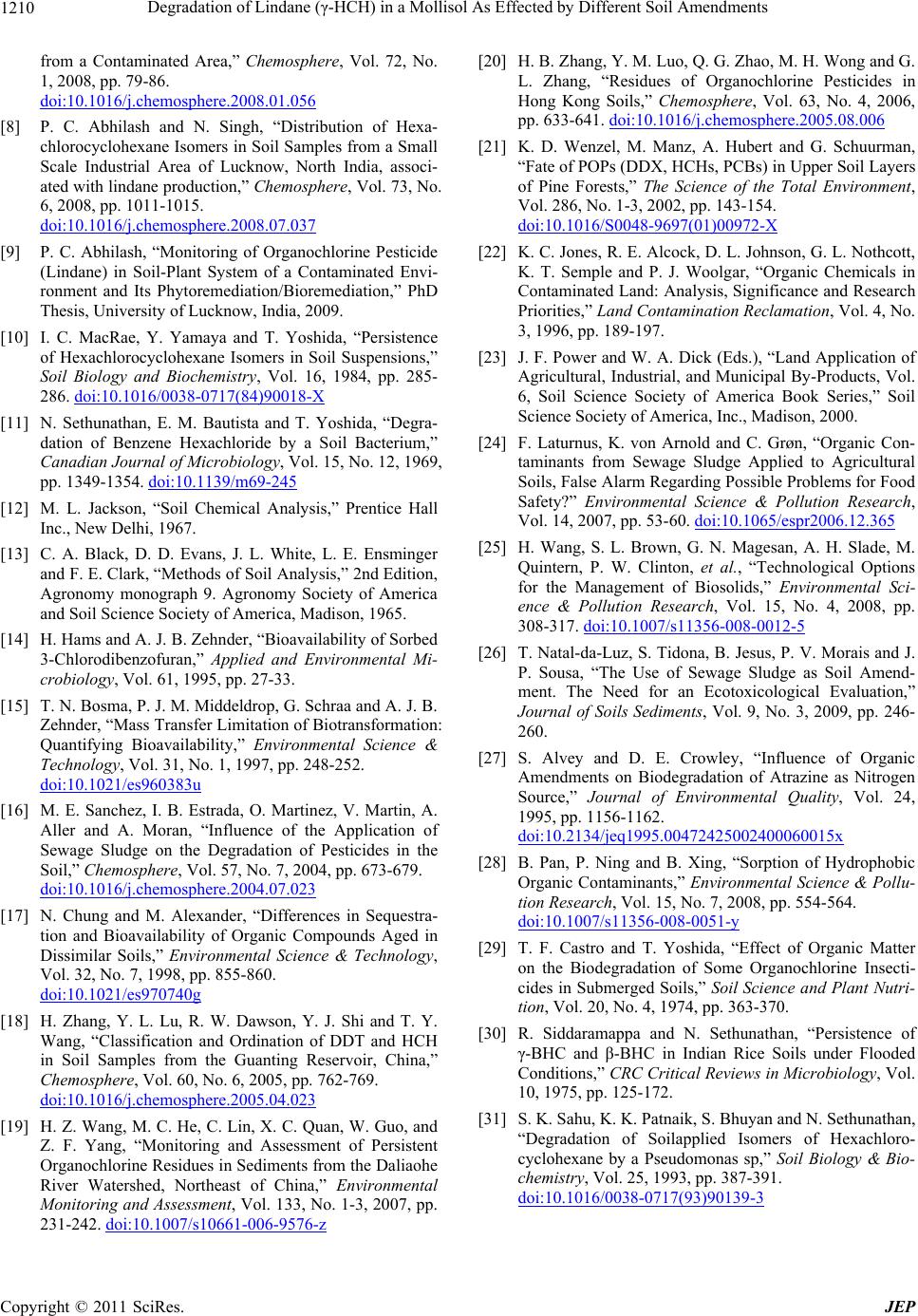
Degradation of Lindane (γ-HCH) in a Mollisol As Effected by Different Soil Amendments
Copyright © 2011 SciRes. JEP
1210
from a Contaminated Area,” Chemosphere, Vol. 72, No.
1, 2008, pp. 79-86.
doi:10.1016/j.chemosphere.2008.01.056
[8] P. C. Abhilash and N. Singh, “Distribution of Hexa-
chlorocyclohexane Isomers in Soil Samples from a Small
Scale Industrial Area of Lucknow, North India, associ-
ated with lindane production,” Chemosphere, Vol. 73, No.
6, 2008, pp. 1011-1015.
doi:10.1016/j.chemosphere.2008.07.037
[9] P. C. Abhilash, “Monitoring of Organochlorine Pesticide
(Lindane) in Soil-Plant System of a Contaminated Envi-
ronment and Its Phytoremediation/Bioremediation,” PhD
Thesis, University of Lucknow, India, 2009.
[10] I. C. MacRae, Y. Yamaya and T. Yoshida, “Persistence
of Hexachlorocyclohexane Isomers in Soil Suspensions,”
Soil Biology and Biochemistry, Vol. 16, 1984, pp. 285-
286. doi:10.1016/0038-0717(84)90018-X
[11] N. Sethunathan, E. M. Bautista and T. Yoshida, “Degra-
dation of Benzene Hexachloride by a Soil Bacterium,”
Canadian Journal of Microbiology, Vol. 15, No. 12, 1969,
pp. 1349-1354. doi:10.1139/m69-245
[12] M. L. Jackson, “Soil Chemical Analysis,” Prentice Hall
Inc., New Delhi, 1967.
[13] C. A. Black, D. D. Evans, J. L. White, L. E. Ensminger
and F. E. Clark, “Methods of Soil Analysis,” 2nd Edition,
Agronomy monograph 9. Agronomy Society of America
and Soil Science Society of America, Madison, 1965.
[14] H. Hams and A. J. B. Zehnder, “Bioavailability of Sorbed
3-Chlorodibenzofuran,” Applied and Environmental Mi-
crobiology, Vol. 61, 1995, pp. 27-33.
[15] T. N. Bosma, P. J. M. Middeldrop, G. Schraa and A. J. B.
Zehnder, “Mass Transfer Limitation of Biotransformation:
Quantifying Bioavailability,” Environmental Science &
Technology, Vol. 31, No. 1, 1997, pp. 248-252.
doi:10.1021/es960383u
[16] M. E. Sanchez, I. B. Estrada, O. Martinez, V. Martin, A.
Aller and A. Moran, “Influence of the Application of
Sewage Sludge on the Degradation of Pesticides in the
Soil,” Chemosphere, Vol. 57, No. 7, 2004, pp. 673-679.
doi:10.1016/j.chemosphere.2004.07.023
[17] N. Chung and M. Alexander, “Differences in Sequestra-
tion and Bioavailability of Organic Compounds Aged in
Dissimilar Soils,” Environmental Science & Technology,
Vol. 32, No. 7, 1998, pp. 855-860.
doi:10.1021/es970740g
[18] H. Zhang, Y. L. Lu, R. W. Dawson, Y. J. Shi and T. Y.
Wang, “Classification and Ordination of DDT and HCH
in Soil Samples from the Guanting Reservoir, China,”
Chemosphere, Vol. 60, No. 6, 2005, pp. 762-769.
doi:10.1016/j.chemosphere.2005.04.023
[19] H. Z. Wang, M. C. He, C. Lin, X. C. Quan, W. Guo, and
Z. F. Yang, “Monitoring and Assessment of Persistent
Organochlorine Residues in Sediments from the Daliaohe
River Watershed, Northeast of China,” Environmental
Monitoring and Assessment, Vol. 133, No. 1-3, 2007, pp.
231-242. doi:10.1007/s10661-006-9576-z
[20] H. B. Zhang, Y. M. Luo, Q. G. Zhao, M. H. Wong and G.
L. Zhang, “Residues of Organochlorine Pesticides in
Hong Kong Soils,” Chemosphere, Vol. 63, No. 4, 2006,
pp. 633-641. doi:10.1016/j.chemosphere.2005.08.006
[21] K. D. Wenzel, M. Manz, A. Hubert and G. Schuurman,
“Fate of POPs (DDX, HCHs, PCBs) in Upper Soil Layers
of Pine Forests,” The Science of the Total Environment,
Vol. 286, No. 1-3, 2002, pp. 143-154.
doi:10.1016/S0048-9697(01)00972-X
[22] K. C. Jones, R. E. Alcock, D. L. Johnson, G. L. Nothcott,
K. T. Semple and P. J. Woolgar, “Organic Chemicals in
Contaminated Land: Analysis, Significance and Research
Priorities,” Land Contamination Reclamation, Vol. 4, No.
3, 1996, pp. 189-197.
[23] J. F. Power and W. A. Dick (Eds.), “Land Application of
Agricultural, Industrial, and Municipal By-Products, Vol.
6, Soil Science Society of America Book Series,” Soil
Science Society of America, Inc., Madison, 2000.
[24] F. Laturnus, K. von Arnold and C. Grøn, “Organic Con-
taminants from Sewage Sludge Applied to Agricultural
Soils, False Alarm Regarding Possible Problems for Food
Safety?” Environmental Science & Pollution Research,
Vol. 14, 2007, pp. 53-60. doi:10.1065/espr2006.12.365
[25] H. Wang, S. L. Brown, G. N. Magesan, A. H. Slade, M.
Quintern, P. W. Clinton, et al., “Technological Options
for the Management of Biosolids,” Environmental Sci-
ence & Pollution Research, Vol. 15, No. 4, 2008, pp.
308-317. doi:10.1007/s11356-008-0012-5
[26] T. Natal-da-Luz, S. Tidona, B. Jesus, P. V. Morais and J.
P. Sousa, “The Use of Sewage Sludge as Soil Amend-
ment. The Need for an Ecotoxicological Evaluation,”
Journal of Soils Sediments, Vol. 9, No. 3, 2009, pp. 246-
260.
[27] S. Alvey and D. E. Crowley, “Influence of Organic
Amendments on Biodegradation of Atrazine as Nitrogen
Source,” Journal of Environmental Quality, Vol. 24,
1995, pp. 1156-1162.
doi:10.2134/jeq1995.00472425002400060015x
[28] B. Pan, P. Ning and B. Xing, “Sorption of Hydrophobic
Organic Contaminants,” Environmental Science & Pollu-
tion Research, Vol. 15, No. 7, 2008, pp. 554-564.
doi:10.1007/s11356-008-0051-y
[29] T. F. Castro and T. Yoshida, “Effect of Organic Matter
on the Biodegradation of Some Organochlorine Insecti-
cides in Submerged Soils,” Soil Science and Plant Nutri-
tion, Vol. 20, No. 4, 1974, pp. 363-370.
[30] R. Siddaramappa and N. Sethunathan, “Persistence of
γ-BHC and β-BHC in Indian Rice Soils under Flooded
Conditions,” CRC Critical Reviews in Microbiology, Vol.
10, 1975, pp. 125-172.
[31] S. K. Sahu, K. K. Patnaik, S. Bhuyan and N. Sethunathan,
“Degradation of Soilapplied Isomers of Hexachloro-
cyclohexane by a Pseudomonas sp,” Soil Biology & Bio-
chemistry, Vol. 25, 1993, pp. 387-391.
doi:10.1016/0038-0717(93)90139-3